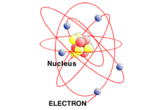Ties That Bind Atoms Weaker Than Thought

A fundamental force that holds electrons inside atoms and governs how charged particles and light interact is a little weaker than previously thought, scientists reported today.
The strength of electromagnetic force, one of the four fundamental forces of nature, is specified through a value known as the fine structure constant.? Through studying an individual electron in isolation, scientists were able to calculate a new value for this number that is six times more precise than previous estimates.
"Little did we know that the binding energies of all the atoms in the universe were smaller by a millionth of a percent--a lot of energy given the huge number of atoms in the universe," said Gerald Gabrielse, a researcher at Harvard University.
Gabrielse and his colleagues developed a giant atom by isolating an electron in a bottle devoid of almost all particles and chilled to temperatures colder than the surface of Pluto.
Similar to a real atom, they kept the lone electron in circular motion through electric and magnetic forces. The electron also wobbled down in the direction of the magnetic field, a setup similar to a merry-go-round, with an electromagnetic trap as the carousel and the electron as the lone horse.
The setup was sensitive enough to sense when the electron is moving upwards and when the motion is restricted, allowing the electron's energy to be precisely measured. This helped refine measurements of the fine structure constant.
The more precise value could help improve the design of electric devices and aid scientists in the details of the workings of the universe, the researchers say.?
Get the world’s most fascinating discoveries delivered straight to your inbox.
These results appear in two papers in the July 21 issue of the journal Physical Review Letters.



